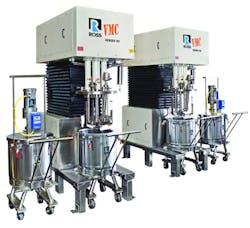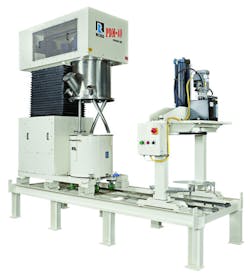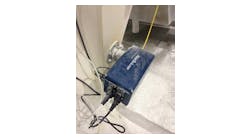5 ways to reduce labor costs in mixing operations
As we go deeper into 2019, an already historically tight U.S. labor market is expected to continue on the same trend. A shrinking surplus labor pool paired with strong competition among companies to hire good people unfortunately breeds the conditions for high turnover. Simply put, job seekers — employed and unemployed alike — have more choices. Small businesses are especially hit hard, but the vast manufacturing industry is not exempt from this challenge.
When done efficiently, mixing normally constitutes only a minor percentage of the total manufacturing cost. Inefficient mixing, on the other hand, can be an expensive operation that can hurt the bottom line. Poor mixing can cause lost value due to low yield, product contamination, corrections, reworks, prolonged cycle times and intensive cleanup. On the balance sheets, these negative consequences of poor mixing translate to increased use of raw materials and energy but perhaps more significantly, they lead to higher labor costs.
Figure 2. Ross Multi-Shaft Mixers supplied with interchangeable vessels that also serve as holding tanks prior to the packaging step. After each mixing cycle, the vessel containing finished product is simply pulled from under the mixer and fitted with a custom cover while another vessel is rolled into the mixing position. The cover for the holding tank is secured via quick-acting clamps and suitable for 2 psi inert gas purge. An impeller agitator mounted to a tri-clamp port on the cover prevents any settling or separation.
In reviewing your current or future mixing process, here are five essential points to consider:
1. Equip your process with the right mixer. Being both art and science, mixing can often be accomplished in various ways and still arrive at the same end product. The choices can be overwhelming but an experienced mixer supplier can help narrow down your list to no more than two or three best candidates. Test these mixers using your actual raw materials, simulating process conditions as closely as possible. A proof-of-concept mixing demonstration will determine if you can combine multiple operations in one machine and eliminate extraneous transfer steps. Once you have zoned in on a particular design, try the mixer and perform further testing in your facility, if practical. This exercise will help you perfect the order and method of raw material additions, as well as jump-start operator training. Ensuring that you have the right equipment and process in place is the first step to optimizing labor costs.
2. Re-evaluate your batch size as production expands. Many process engineers answer the call for greater capacity by simply adding more mixers identical to the ones they already have. This strategy increases production but may fail to capture economies of scale. With every square foot of floor space occupied by numerous small mixers, the associated labor costs also go up when they really don’t need to if only a larger mixer is used instead. Minimize the frequency of mixing and cleaning cycles to hit production targets while avoiding costly overtime.
3. Consider if semi-continuous mixing is appropriate for your process. For example, many mixing systems up to 500-gallon capacities can be supplied in a "change-can" design. Using multiple interchangeable vessels with a single mixer, one tank could be at the loading stage, another under the mixer, another at the discharge step and yet another at the cleanup stage. This arrangement maximizes both machine and labor utilization. Another practical feature of the change-can design is the ability to dedicate each vessel to a particular formulation or product color, simplifying the cleaning procedure.
Figure 3. Planetary disperser and discharge system on a common raised base. V tracks allow for easy transport of the vessel between the mixer to the discharge station. During the discharge process, the platen is lowered hydraulically into the vessel and pushes down on the batch. Sidewall surfaces are virtually wiped clean by an O-ring around the platen. Product is forced out through a valve on the bottom of the vessel and into 5-gallon pails positioned right under the base.
4. Pay attention to control system design. A well-designed control system is another crucial component in optimizing labor related to the mixing operation. At the same time, it offers many other important benefits:
- Higher product yield (less rejects) especially for applications that are highly process-sensitive.
- Lower production cost not only due to less labor, but also because of less waste and energy consumption.
- Shorter cycle time. Delays attributed to frequent rework, incorrect mixing instructions and weighing errors are significantly reduced, if not eliminated.
- Longer service life. An appropriate control system provides electronic soft start for the agitator(s), overload protection and other features that help prevent premature wear and mechanical failure. Proper routine maintenance and calibration can also be programmed into the programmable logic controller (PLC) recipe controls so operators are less likely to overlook such procedures.
- Better monitoring and recordkeeping. PLCs with customized human machine interface (HMI) and supervisory control and data acquisition (SCADA) packages enable automatic datalogging. Such systems support complete traceability and comply with regulatory requirements covering sensitive applications like food, pharmaceutical and medical products. As a managing tool, PLCs also make it easier to pool statistical information on typical workloads and bottlenecks.
- Improved safety. Automation offers improved safety to mixing processes by limiting operator exposure to hazardous chemicals and extreme temperatures.
5. Simplify discharge and cleaning. Viscous mixtures are most notorious for consuming extended man-hours dedicated just to discharge and cleanup. An automated discharge system can tremendously reduce labor costs by accelerating product transfer while also preparing the mix vessel for easy cleanup.
Christine Banaszek is the sales manager at Charles Ross & Son Company, manufacturer of specialty mixing and blending equipment. As an application engineer at the corporate headquarters in Hauppauge, New York, she has worked at the Ross Test & Development Center and published many articles and whitepapers in mixing and blending technologies, applications and best practices. She holds a degree in chemical engineering.





